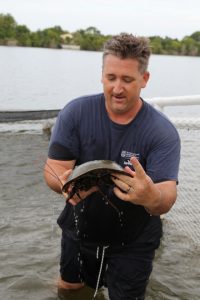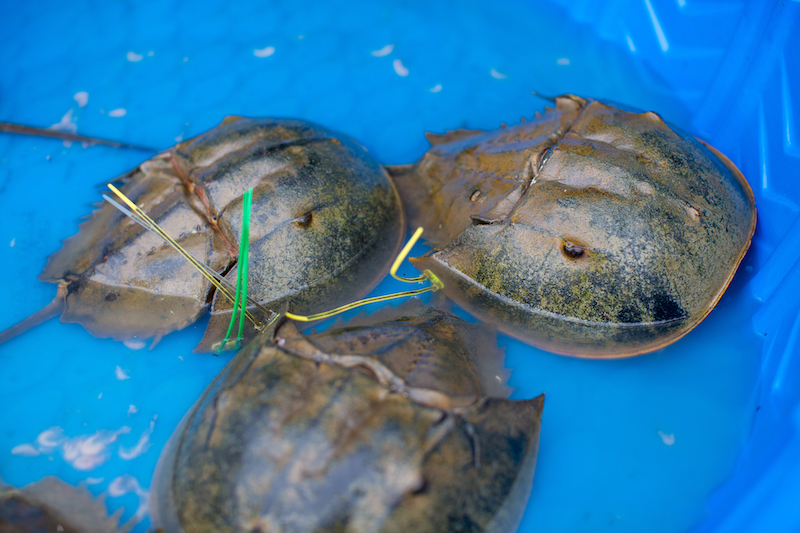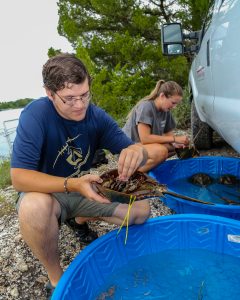Pacemakers, prosthetic implants, antibiotics, in fact every medicine or medical device approved by the U.S. Food and Drug Administration, depend on the horseshoe crab.
A protein in the blue blood of the crab is used to test medicine and medical devices for bacteria before they are used on humans, saving millions of people from infection.
But to get the blood, the horseshoe crabs must be harvested and bled. Though they are returned to the ocean, studies have shown that some die and females are unable to produce as many offspring. Scientists are working to create a synthetic version of the protein.
Until they create it, marine researchers like those at UGA are exploring ways to protect the species from decline.
UGA Marine Extension and Georgia Sea Grant is working with a pharmaceutical company to farm the horseshoe crabs in their natural habitats on Jekyll Island, as a way to maintain the blood supply without depleting the horseshoe crab population.
“It’s a semi-natural environment in the fact that it’s tidally influenced, full of marine life and it would be similar to what they might experience out in the wild,” says Bryan Fluech, associate director of Marine Extension and Georgia Sea Grant.

Bryan Fluech holds a horseshoe crab used in the study.
Fluech and marine resource specialist Lisa Gentit worked with Kepley BioSystems Inc., based in North Carolina, to construct four, 5-by-15 foot holding pens to house the horseshoe crabs in a saltwater influenced tidal pond, established in cooperation with the Jekyll Island Authority and the UGA 4-H Tidelands Nature Center on Jekyll Island.
The site was ideal for the study because it was easy to access and because the environmental conditions in the pond are comparable to Georgia’s estuaries, where horseshoe crabs are commonly found.
Over the course of the six-month project, Fluech and Gentit monitored water quality and conducted routine health assessments of the crabs to assess their responses to being in the enclosures.
“Think about humans,“ Fluech says. “We give blood and if we’re not careful we can get woozy and it can affect our health. The same can be true of horseshoe crabs. In addition to drawing their blood, we are also taking them out of their natural environment, hauling them to a bleeding center and returning them to their home hours or days later.”
Current methods of harvesting crabs often involve removing and transporting them, sometimes hundreds of miles from their natural habitat, to bleeding facilities where almost a third of their blood is extracted before they are returned to the wild.
The stress of removing them from their natural environment, collecting the blood, then releasing them without feeding or providing further care can have negative impacts on their health.
“If we can keep the crabs healthy, instead of bleeding the crabs once a year for about 30% of their blood, maybe, through careful husbandry, we could bleed them multiple times a year for a smaller percentage of their blood,” says Kristen Dellinger, a research scientist at Kepley and principal investigator on the horseshoe crab project.
Dellinger said several studies have explored sustainable harvesting methods, but none have taken the approach of housing them in environments that are similar to their natural habitat.
“There have been some attempts to raise horseshoe crabs in captivity for bleeding purposes, but, to my knowledge, those studies were done in closed tanks and the horseshoe crabs were given a fixed diet,” Dellinger says. “We’re curious whether this is what caused their blood quality to decline.”

Kristen Dellinger holds a sample of horseshoe crab blood.
The project, funded by the National Science Foundation Small Business Innovation Research grant, involved conducting periodic bleeding and monitoring of 40 tagged horseshoe crabs that were kept in the enclosures at the research site on Jekyll Island.
The horseshoe crab’s blood contains a compound called LAL, or limulus amebocyte lysate, which causes blood to clot around deadly endotoxins, trapping them and keeping them from spreading. Thanks to this special compound, millions of patients are protected from bacterial contaminants each year.
Unfortunately, the widespread use of LAL comes at a cost to the hundreds of thousands of wild horseshoe crabs that are harvested annually for their blood.
In the outdoor, submerged enclosures on Jekyll Island, the crabs had access to natural food on the bottom of the pond and they experienced tidal rhythms as well as day and night cycles, all of which are things they experience in the wild.

Horseshoe crabs used in the study were tagged prior to having to having their blood drawn.
“In a perfect world, you’d satisfy the global needs of LAL with diet, care and appropriate breeding from a captive population that can continue to flourish as well as provide a service to the medical industry,” Dellinger says.
In addition to looking at the environmental conditions, the research team tested different bleeding methods in an effort to optimize the way the blood is collected with the ultimate goal of using less blood.
Some studies have shown that the bleeding process can impact the spawning patterns of female horseshoe crabs, with some spawning less frequently or not spawning at all. Findings such as this are alarming not only when it comes to maintaining healthy horseshoe crab populations, but also for other animals that depend on the crabs for survival.
Threatened shorebirds like the red knot rely on horseshoe crab eggs for essential nutrition during their annual migration. They time their migration to arrive during spawning season so they can feast on the eggs that fuel their annual flight to nesting grounds in the Arctic.
Because of their benefits to humans as well as their ecological significance, it’s in everyone’s best interest to keep a healthy population of crabs, Dellinger said.
During the six-month project, Fluech collaborated with university partners on a number of initiatives connected to the study, with the goal of spreading awareness about the project and the environmental importance of horseshoe crabs.
Fluech is working with Dawn Zenkert, coordinator of the UGA 4-H Tidelands Nature Center, to incorporate information about the project into educational activities at the center.
“We’ve been able to stop there and share information about the project with students and campers,” Zenkert says. “It has been great just being able to talk about it with visitors. Last week we had a couple visiting from Canada who learned about it.”
Campers kayaking in the tidelands pond as well as those who passed by the site on their way to the salt marsh routinely stopped to talk with Marine Extension and Georgia Sea Grant interns Cole Wilder and Ivy Spratling, who assisted with the project over the summer. These interactions allowed Wilder and Spratling not only to gain experience in research and experimental design, but also to cultivate their informal education skills.

Cole Wilder (left) and Ivy Spratling (right) feed horseshoe crabs used in the study.
“This whole experience has helped me fine-tune some of the tips and tricks that I’ve already started building and geared them more towards what I think would be very helpful in a professional career in environmental education,” says Wilder, who recently graduated from the College of Coastal Georgia (CCGA) with a bachelor’s degree in biological sciences. He plans to pursue a career in environmental education or animal husbandry.
Fluech also worked with CCGA Associate Professor David Stasek and his students on a small side project that involved sampling invertebrates like clams, crustaceans and worms at the horseshoe crab enclosure site.
Every other week the students identified and recorded the amount and type of invertebrates in each sample in order to create a diversity index of invertebrates commonly found where the horseshoe crabs live. Knowing what type of natural food is available to the crabs is useful for the project team.
“We’ve been able to have value added because of the connections we have here with our community partners,” Fluech says. “Regardless of the intended outcomes of this project, from a public service perspective we’re successfully advancing knowledge of the industry and supporting efforts to preserve horseshoe crab populations.”

